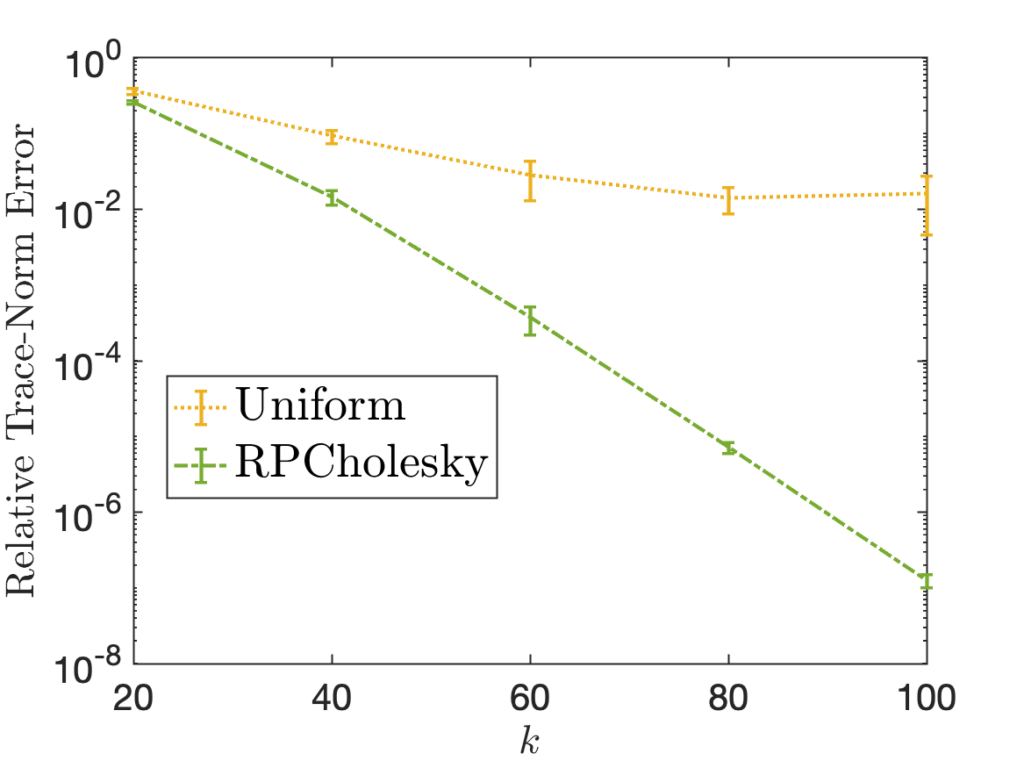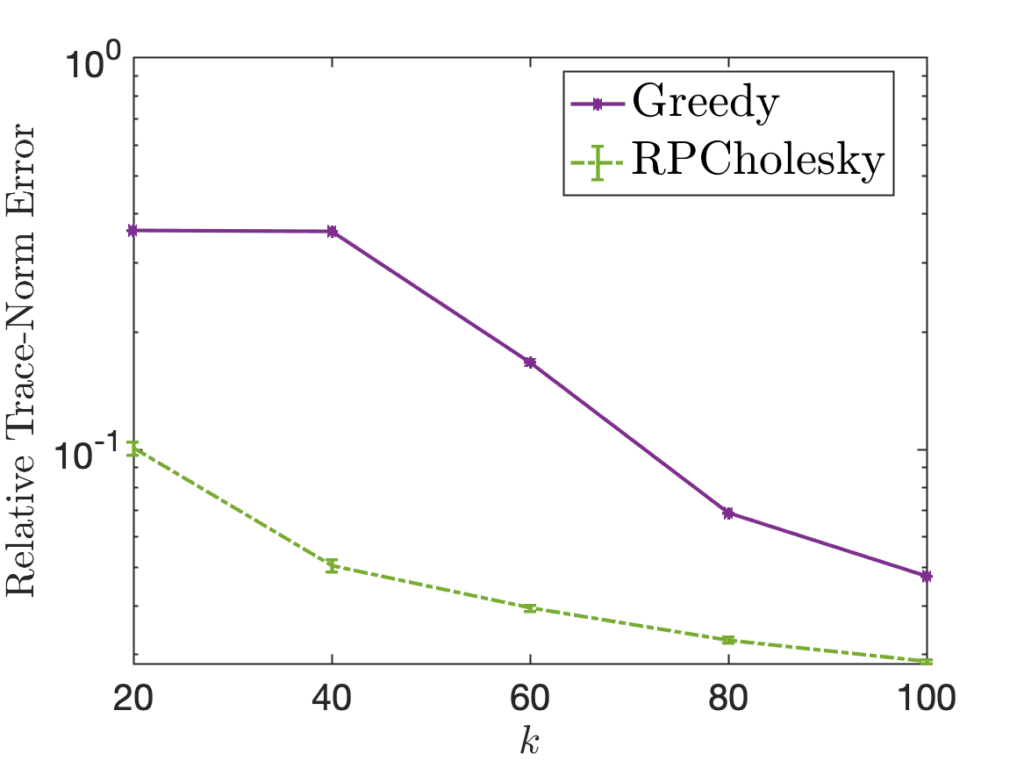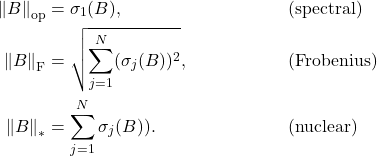In the previous post, we looked at the randomized SVD. In this post, we continue this discussion by looking at the analysis of the randomized SVD. Our approach is adapted from a new analysis of the randomized SVD by Joel A. Tropp and Robert J. Webber.
There are many types of analysis one can do for the randomized SVD. For instance, letting ![]() be a matrix and
be a matrix and ![]() the rank-
the rank-![]() output of the randomized SVD, natural questions include:
output of the randomized SVD, natural questions include:
- What is the expected error
 measured in some norm
measured in some norm  ? What about expected squared error
? What about expected squared error  ? How do these answers change with different norms?
? How do these answers change with different norms? - How large can the randomized SVD error
 get except for some small failure probability
get except for some small failure probability  ?
? - How close is the randomized SVD truncated to rank
 compared to the best rank-
compared to the best rank- approximation to
approximation to  ?
? - How close are the singular values and vectors of the randomized SVD approximation
 compared to those of
compared to those of  ?
?
Implicitly and explicitly, the analysis of Tropp and Webber provides satisfactory answers to a number of these questions. In the interest of simplifying the presentation, we shall focus our presentation on just one of these questions, proving following result:
![]()
Here, ![]() is the Frobenius norm. We encourage the interested reader to check out Tropp and Webber’s paper to see the methodology we summarize here used to prove numerous facts about the randomized SVD and its extensions using subspace iteration and block Krylov iteration.
is the Frobenius norm. We encourage the interested reader to check out Tropp and Webber’s paper to see the methodology we summarize here used to prove numerous facts about the randomized SVD and its extensions using subspace iteration and block Krylov iteration.
Projection Formula
Let us recall the randomized SVD as we presented it in last post:
- Collect information. Form
 where
where  is an appropriately chosen
is an appropriately chosen  random matrix.
random matrix. - Orthogonalize. Compute an orthonormal basis
 for the column space of
for the column space of  by, e.g., thin QR factorization.
by, e.g., thin QR factorization. - Project. Form
 , where
, where  denotes the conjugate transpose.
denotes the conjugate transpose.
The randomized SVD is the approximation
![]()
It is easy to upgrade ![]() into a compact SVD form
into a compact SVD form ![]() , as we did as steps 4 and 5 in the previous post.
, as we did as steps 4 and 5 in the previous post.
For the analysis of the randomized SVD, it is helpful to notice that the approximation ![]() takes the form
takes the form
![]()
Here, ![]() denotes the orthogonal projection onto the column space of the matrix
denotes the orthogonal projection onto the column space of the matrix ![]() . We call
. We call ![]() the projection formula for the randomized SVD.1This formula bares a good deal of similarity to the projection formula for the Nyström approximation. This is not a coincidence.
the projection formula for the randomized SVD.1This formula bares a good deal of similarity to the projection formula for the Nyström approximation. This is not a coincidence.
Aside: Quadratic Unitarily Invariant Norms
To state our error bounds in the most general language, we can adopt the language of quadratic unitarily invariant norms. Recall that a square matrix ![]() is unitary if
is unitary if
![]()
You may recall from my post on Nyström approximation that a norm ![]() on matrices is unitarily invariant if
on matrices is unitarily invariant if
![]()
A unitarily invariant norm ![]() is said to be quadratic if there exists another unitarily invariant norm
is said to be quadratic if there exists another unitarily invariant norm ![]() such that
such that
(1) ![]()
Many examples of quadratic unitarily invariant norms are found among the Schatten ![]() -norms, defined as
-norms, defined as
![]()
Here, ![]() denote the decreasingly order singular values of
denote the decreasingly order singular values of ![]() . The Schatten
. The Schatten ![]() -norm
-norm ![]() is the Frobenius norm of a matrix. The spectral norm (i.e., operator 2-norm) is the Schatten
is the Frobenius norm of a matrix. The spectral norm (i.e., operator 2-norm) is the Schatten ![]() -norm, defined to be
-norm, defined to be
![]()
The Schatten ![]() -norms are unitarily invariant norms for every
-norms are unitarily invariant norms for every ![]() . However, the Schatten
. However, the Schatten ![]() -norms are quadratic unitarily invariant norms only for
-norms are quadratic unitarily invariant norms only for ![]() since
since
![]()
For the remainder of this post, we let ![]() and
and ![]() be a quadratic unitarily invariant norm pair satisfying (1).
be a quadratic unitarily invariant norm pair satisfying (1).
Error Decomposition
The starting point of our analysis is the following decomposition of the error of the randomized SVD:
(2) ![]()
Recall that we have defined ![]() to be an optimal rank-
to be an optimal rank-![]() approximation to
approximation to ![]() :
:
![]()
Thus, the error decomposition says that the excess error is bounded by
![]()
Using the projection formula, we can prove the error decomposition (2) directly:
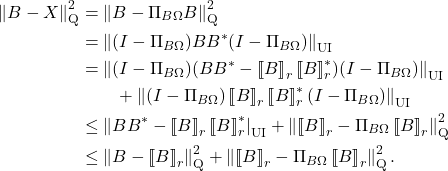
The first line is the projection formula, the second is relation between ![]() and
and ![]() , and the third is the triangle inequality. For the fifth line, we use the fact that
, and the third is the triangle inequality. For the fifth line, we use the fact that ![]() is an orthoprojector and thus has unit spectral norm
is an orthoprojector and thus has unit spectral norm ![]() together with the fact that
together with the fact that
![]()
For the final inequality, we used commutation rule
![]()
Bounding the Error
In this section, we shall continue to refine the error decomposition (2). Consider a thin SVD of ![]() , partitioned as
, partitioned as
![]()
where
 and
and  both have orthonormal columns,
both have orthonormal columns, and
and  are square diagonal matrices with nonnegative entries,
are square diagonal matrices with nonnegative entries, and
and  have
have  columns, and
columns, and is an
is an  matrix.
matrix.
Under this notation, the best rank-![]() approximation is
approximation is ![]() . Define
. Define
![]()
We assume throughout that ![]() is full-rank (i.e.,
is full-rank (i.e., ![]() ).
).
Applying the error decomposition (2), we get
(3) 
For the second line, we used the unitary invariance of ![]() . Observe that the column space of
. Observe that the column space of ![]() is a subset of the column space of
is a subset of the column space of ![]() so
so
(4) ![]()
Let’s work on simplifying the expression
![]()
First, observe that
![]()
Thus, the projector ![]() takes the form
takes the form
![Rendered by QuickLaTeX.com \begin{align*}\Pi_{B\Omega\Omega_1^\dagger} &= (B\Omega\Omega_1^\dagger) \left[(B\Omega\Omega_1^\dagger)^*(B\Omega\Omega_1^\dagger)\right]^\dagger (B\Omega\Omega_1^\dagger)^* \\&= (U_1\Sigma_1 + U_2\Sigma_2\Omega_2\Omega_1^\dagger) \left[\Sigma_1^2 + (\Sigma_2\Omega_2\Omega_1^\dagger)^*(\Sigma_2\Omega_2\Omega_1^\dagger)\right]^\dagger (U_1\Sigma_1 + U_2\Sigma_2\Omega_2\Omega_1^\dagger)^*.\end{align*}](https://www.ethanepperly.com/wp-content/ql-cache/quicklatex.com-0529f1a850ae843aa87df021d5169999_l3.png)
Here, ![]() denotes the Moore–Penrose pseudoinverse, which reduces to the ordinary matrix inverse for a square nonsingular matrix. Thus,
denotes the Moore–Penrose pseudoinverse, which reduces to the ordinary matrix inverse for a square nonsingular matrix. Thus,
(5) ![]()
Remarkably, this seemingly convoluted combination of matrices actually is a well-studied operation in matrix theory, the parallel sum. The parallel sum of positive semidefinite matrices ![]() and
and ![]() is defined as
is defined as
(6) ![]()
We will have much more to say about the parallel sum soon. For now, we use this notation to rewrite (5) as
![]()
Plugging this back into (4) and then (3), we obtain the error bound
(7) ![]()
Simplifying this expression further will require more knowledge about parallel sums, which we shall discuss now.
Aside: Parallel Sums
Let us put aside the randomized SVD for a moment and digress to the seemingly unrelated topic of electrical circuits. Suppose we have a battery of voltage ![]() and we connect the ends using a wire of resistance
and we connect the ends using a wire of resistance ![]() . The current
. The current ![]() is given by Ohm’s law
is given by Ohm’s law
![]()
Similarly, if the wire is replaced by a different wire with resistance ![]() , the current
, the current ![]() is then
is then
![]()
Now comes the interesting question. What if we connect the battery by both wires (resistances ![]() and
and ![]() ) simultaneously in parallel, so that current can flow through either wire? Since wires of resistances
) simultaneously in parallel, so that current can flow through either wire? Since wires of resistances ![]() and
and ![]() still have voltage
still have voltage ![]() , Ohm’s law still applies and thus the total current is
, Ohm’s law still applies and thus the total current is
![]()
The net effect of connecting resisting wires of resistances ![]() and
and ![]() is the same as a single resisting wire of resistance
is the same as a single resisting wire of resistance
(8) ![]()
We call the the operation ![]() the parallel sum of
the parallel sum of ![]() and
and ![]() because it describes how resistances combine when connected in parallel.
because it describes how resistances combine when connected in parallel.
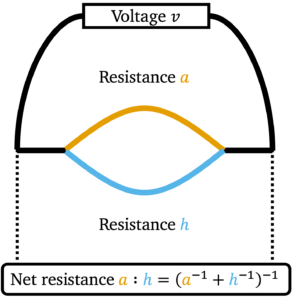
The parallel sum operation ![]() can be extended to all nonnegative numbers
can be extended to all nonnegative numbers ![]() and
and ![]() by continuity:
by continuity:
![Rendered by QuickLaTeX.com \[a:h \coloneqq \lim_{b\downarrow a, \: k\downarrow h} b:k = \begin{cases}\left( a^{-1}+h^{-1}\right)^{-1}, & a,h > 0 ,\\0, & \textrm{otherwise}.\end{cases}\]](https://www.ethanepperly.com/wp-content/ql-cache/quicklatex.com-690aff4453bc4ce2b64671a0c9ac2eef_l3.png)
Electrically, this definition states that one obtains a short circuit (resistance ![]() ) if either of the wires carries zero resistance.
) if either of the wires carries zero resistance.
Parallel sums of matrices were introduced by William N. Anderson, Jr. and Richard J. Duffin as a generalization of the parallel sum operation from electrical circuits. There are several equivalent definitions. The natural definition (8) applies for positive definite matrices
![]()
This definition can be extended to positive semidefinite matrices by continuity. It can be useful to have an explicit definition which applies even to positive semidefinite matrices. To do so, observe that the (scalar) parallel sum satisfies the identity
![]()
To extend to matrices, we capitalize the letters and use the Moore–Penrose pseudoinverse in place of the inverse:
![]()
This was the definition (6) of the parallel sum we gave above which we found naturally in our randomized SVD error bounds.
The parallel sum enjoys a number of beautiful properties, some of which we list here:
- Symmetry.
 ,
, - Simplified formula.
 for positive definite matrices,
for positive definite matrices, - Bounds.
 and
and  .
. - Monotone.
 is monotone in the Loewner order.
is monotone in the Loewner order. - Concavity. The map
 is (jointly) concave (with respect to the Loewner order).
is (jointly) concave (with respect to the Loewner order). - Conjugation. For any square
 ,
,  .
. - Trace.
 .2In fact, this property holds with the trace replaced by any positive linear map. That is, if
.2In fact, this property holds with the trace replaced by any positive linear map. That is, if  is a linear map from square matrices to square matrices satisfying
is a linear map from square matrices to square matrices satisfying  if
if  , then
, then  .
. - Unitarily invariant norms.
 .
.
For completionists, we include a proof of the last property for reference.
Nearing the Finish: Enter the Randomness
Equipped with knowledge about parallel sums, we are now prepared to return to bounding the error of the randomized SVD. Apply property 8 of the parallel sum to the randomized SVD bound (7) to obtain
![Rendered by QuickLaTeX.com \begin{align*}\left\|B - X\right\|_{\rm Q}^2&\le \left\| \Sigma_2 \right\|_{\rm Q}^2 + \left\|\Sigma_1^2 : [(\Sigma_2\Omega_2\Omega_1^\dagger)^*(\Sigma_2\Omega_2\Omega_1^\dagger)]\right\|_{\rm UI} \\&\le \left\| \Sigma_2 \right\|_{\rm Q}^2 + \left\|\Sigma_1^2\right\|_{\rm UI} : \left\|[(\Sigma_2\Omega_2\Omega_1^\dagger)^*(\Sigma_2\Omega_2\Omega_1^\dagger)]\right\|_{\rm UI} \\&= \left\| \Sigma_2 \right\|_{\rm Q}^2 + \left\|\Sigma_1\right\|_{\rm Q}^2 : \left\|\Sigma_2\Omega_2\Omega_1^\dagger\right\|^2_{\rm Q}.\end{align*}](https://www.ethanepperly.com/wp-content/ql-cache/quicklatex.com-b30350b9f5930dba7e3beec6fcec30bd_l3.png)
This bound is totally deterministic: It holds for any choice of test matrix ![]() , random or otherwise. We can use this bound to analyze the randomized SVD in many different ways for different kinds of random (or non-random) matrices
, random or otherwise. We can use this bound to analyze the randomized SVD in many different ways for different kinds of random (or non-random) matrices ![]() . Tropp and Webber provide a number of examples instantiating this general bound in different ways.
. Tropp and Webber provide a number of examples instantiating this general bound in different ways.
We shall present only the simplest error bound for randomized SVD. We make the following assumptions:
- The test matrix
 is standard Gaussian.4By which, we mean the entries of
is standard Gaussian.4By which, we mean the entries of  are independent and standard normal.
are independent and standard normal. - The norm
 is the Frobenius norm
is the Frobenius norm  .
. - The randomized SVD rank
 is
is  .
.
Under these assumptions and using the property ![]() , we obtain the following expression for the expected error of the randomized SVD
, we obtain the following expression for the expected error of the randomized SVD
(9) ![]()
All that is left to is compute the expectation of ![]() . Remarkably, this can be done in closed form.
. Remarkably, this can be done in closed form.
Aside: Expectation of Gaussian–Inverse Gaussian Matrix Product
The final ingredient in our randomized SVD analysis is the following computation involving Gaussian random matrices. Let ![]() and
and ![]() be independent standard Gaussian random matrices with
be independent standard Gaussian random matrices with ![]() of size
of size ![]() ,
, ![]() . Then
. Then
![]()
For the probability lovers, we will now go on to prove this. For those who are less probabilistically inclined, this result can be treated as a black box.
Wrapping it All Up
We’re now within striking distance. All that is left is to assemble the pieces we have been working with to obtain a final bound for the randomized SVD.
Recall we have chosen the random matrix ![]() to be standard Gaussian. By the rotational invariance of the Gaussian distribution,
to be standard Gaussian. By the rotational invariance of the Gaussian distribution, ![]() and
and ![]() are independent and standard Gaussian as well. Plugging the matrix expectation bound to (9) then completes the analysis
are independent and standard Gaussian as well. Plugging the matrix expectation bound to (9) then completes the analysis
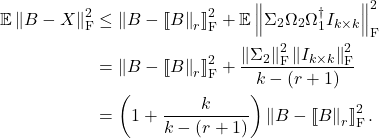
![Rendered by QuickLaTeX.com \begin{align*}\left\|A:H\right\|_{\rm UI} &= \max_{M\succeq 0,\: \left\|M\right\|_{\rm UI}'\le 1} \tr((A:H)M) \\&= \max_{M\succeq 0,\: \left\|M\right\|_{\rm UI}'\le 1} \tr(M^{1/2}(A:H)M^{1/2})\\&= \max_{M\succeq 0,\: \left\|M\right\|_{\rm UI}'\le 1} \tr((M^{1/2}AM^{1/2}):(M^{1/2}HM^{1/2})) \\&\le \max_{M\succeq 0,\: \left\|M\right\|_{\rm UI}'\le 1} \left[\tr(M^{1/2}AM^{1/2}):\tr(M^{1/2}HM^{1/2}) \right] \\&\le \left[\max_{M\succeq 0,\: \left\|M\right\|_{\rm UI}'\le 1} \tr(M^{1/2}AM^{1/2})\right]:\left[\max_{M\succeq 0,\: \left\|M\right\|_{\rm UI}'\le 1} \tr(M^{1/2}HM^{1/2})\right]\\&= \left\|A\right\|_{\rm UI} : \left\|H\right\|_{\rm UI}.\end{align*}](https://www.ethanepperly.com/wp-content/ql-cache/quicklatex.com-5630d659f8235951051f3e7eeb0f6425_l3.png)
![Rendered by QuickLaTeX.com \[\mathbb{E} \left\|SGW\right\|_{\rm F}^2 = \mathbb{E} \sum_{ij} \left(\sum_{k\ell} s_{ik}g_{k\ell}w_{\ell j} \right)^2 = \mathbb{E} \sum_{ijk\ell} s_{ik}^2 w_{\ell j}^2 = \left\|S\right\|_{\rm F}^2\left\|W\right\|_{\rm F}^2.\]](https://www.ethanepperly.com/wp-content/ql-cache/quicklatex.com-04a7e9ee786b4205ee5182cc7b42bcc3_l3.png)
![Rendered by QuickLaTeX.com \[\mathbb{E} \left\|B - X\right\|^2 \le \min_{r \le k-2} \left( 1 + \frac{2r}{k-(r+1)} \right) \left(\sigma_{r+1}^2 + \frac{\mathrm{e}^2}{k-r} \sum_{i>r} \sigma_i^2 \right).\]](https://www.ethanepperly.com/wp-content/ql-cache/quicklatex.com-516cee5dcd03a69b94d82e30744a0782_l3.png)
